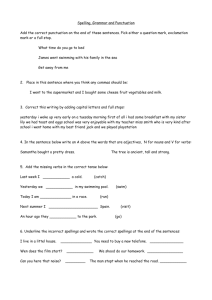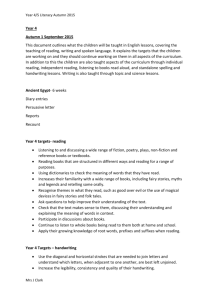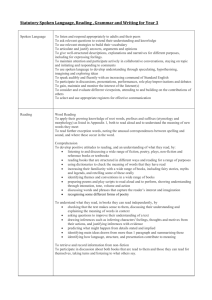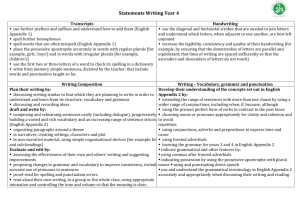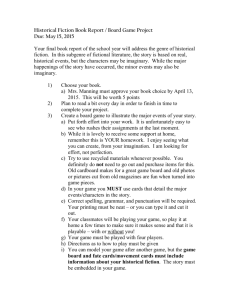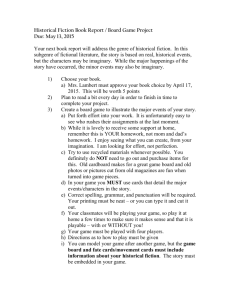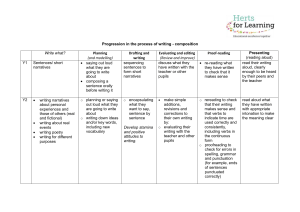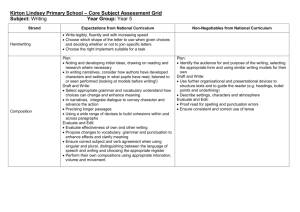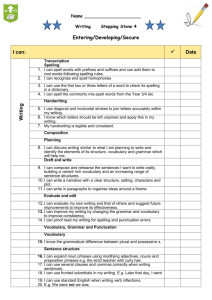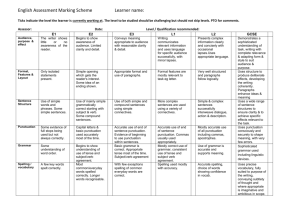Fiction & Non Fiction
advertisement
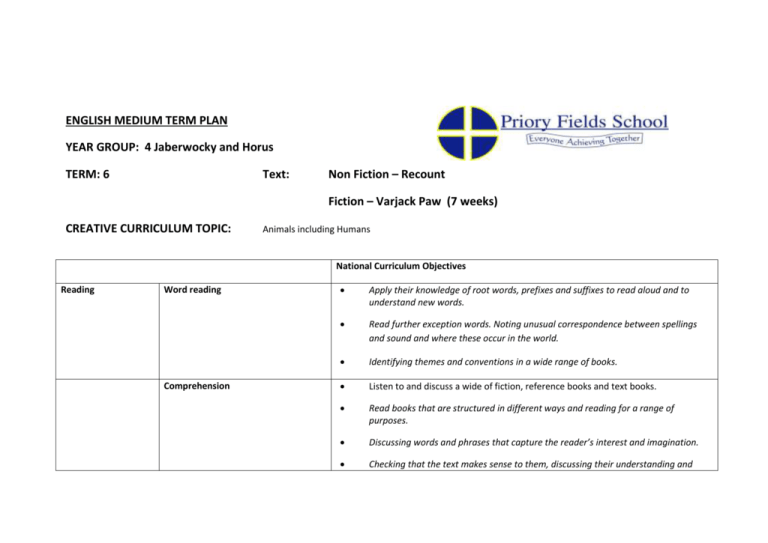
ENGLISH MEDIUM TERM PLAN YEAR GROUP: 4 Jaberwocky and Horus TERM: 6 Text: Non Fiction – Recount Fiction – Varjack Paw (7 weeks) CREATIVE CURRICULUM TOPIC: Animals including Humans National Curriculum Objectives Reading Word reading Comprehension Apply their knowledge of root words, prefixes and suffixes to read aloud and to understand new words. Read further exception words. Noting unusual correspondence between spellings and sound and where these occur in the world. Identifying themes and conventions in a wide range of books. Listen to and discuss a wide of fiction, reference books and text books. Read books that are structured in different ways and reading for a range of purposes. Discussing words and phrases that capture the reader’s interest and imagination. Checking that the text makes sense to them, discussing their understanding and explaining the meaning of words in context. Asking questions to improve their understanding of a text. Drawing inferences, such as inferring character’s feelings thoughts and motives from their actions and justifying inferences with evidence. Predicting what might happen from details stated and implied. Identifying main ideas drawn from more than one paragraph and summarising these. Identifying how language, structure and presentation contribute to meaning. Retrieve and record information from non-fiction. Writing- transcription Spelling Participate in discussion about both books that are read to them and those they can read for themselves, taking turn and listening to what others say. Apply their knowledge of root words, prefixes and suffixes to read aloud and to understand new words Read further exception words. Noting unusual correspondence between spellings and sound and where these occur in the world. Spell further homophones Spell words that are often misspelt. Place the possessive apostrophe accurately in words with regular plurals and in words with irregular plurals. Use the first 2 or 3 letters of a word to check it’s spelling in a dictionary. Write from memory simple sentences, dictated by the teacher, that include words and punctuation taught so far. Handwriting Increase the legibility, consistency and quality of their handwriting, ensuring that the downstroke of letters are parallel and equidistant; that lines of writing are spaced sufficiently so the ascendors and descenders of letters do not touch. Composition Plan their writing by; Discussing writing similar to that which they are planning to write in order to understand and learn from its structure, vocabulary and grammar. Discuss and record ideas Draft and write by; Composing and rehearsing sentences orally (including dialogue), progressively building a varied and rich vocabulary and increasing a range of sentence structures. Organise paragraphs around a theme. In narratives, create settings, characters and plot. Evaluate and edit by; Assessing effectiveness of their own and others’ writing and suggesting improvements. Proposing changes to grammar and vocabulary to improve consistency, including the accurate use of pronouns in sentences. Vocabulary, grammar and punctuation Proof reading for spelling and punctuation errors. Read aloud their own writing, to a group or the whole class, using appropriate intonation and controlling the tone and volume so that the meaning is clear. Develop their understanding of the concepts set out (English Appendix 2) by: Extending the range of sentences with more than one clause by using a wider range of conjunctions, including when, if, because, although Using the present perfect forms of verbs in contrast to the past tense. Choosing nouns or pronouns appropriately for clarity and cohesion and to avoid repetition. Using conjunctions, adverbs, and preposition to express time and cause. Using fronted adverbials. Learning the grammar for years 3 and 4 in English Appendix 2. Indicate grammatical and other features by: Using commas after fronted adverbials. Indicating possession by using the possessive apostrophe with plural nouns. Using punctuation and direct speech. Spoken Language Listen and respond appropriately to adults and their peers. Ask relevant questions to extend their understanding and their knowledge. Use relevant strategies to build their vocabulary. Give well structured descriptions, explanations and narratives for different purposes, including for expressing feelings. Maintain attention and participate actively in collaborative conversations, staying on topic and initiating and responding to ideas. Use spoken language to develop understanding through speculating, hypothesising, imagining and exploring ideas. Speak audibly and fluently with an increasing command of Standard English. Participate in discussions, presentations, performances, role play, improvisations and debates. Gain, maintain and monitor the interest of the listener. Consider and evaluate different viewpoints, attending to and building on the contribution of others. Consider and evaluate different viewpoints, attending to and building on the contributions of others. Select and use appropriate registers for effective communication.

